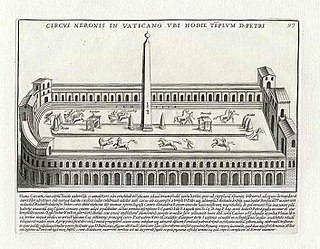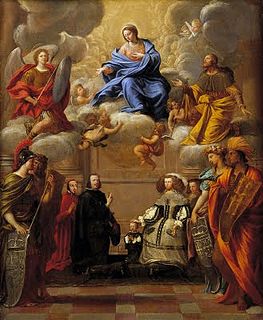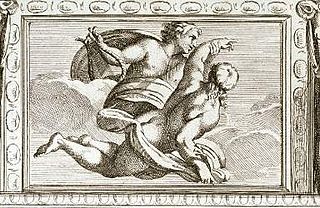Related Research Articles

Francesco Bartolozzi was an Italian engraver, whose most productive period was spent in London. He is noted for popularizing the "crayon" method of engraving.

Pietro da Cortona was an Italian Baroque painter and architect. Along with his contemporaries and rivals Gian Lorenzo Bernini and Francesco Borromini, he was one of the key figures in the emergence of Roman Baroque architecture. He was also an important designer of interior decorations.

Guido Reni was an Italian painter of the Baroque period, although his works showed a classical manner, similar to Simon Vouet, Nicolas Poussin, and Philippe de Champaigne. He painted primarily religious works, but also mythological and allegorical subjects. Active in Rome, Naples, and his native Bologna, he became the dominant figure in the Bolognese School that emerged under the influence of the Carracci.

Giovanni Lanfranco was an Italian painter of the Baroque period.

Pietro Santi Bartoli was an Italian engraver, draughtsman and painter.

Carlo Maratta or Maratti was an Italian painter, active mostly in Rome, and known principally for his classicizing paintings executed in a Late Baroque Classical manner. Although he is part of the classical tradition stemming from Raphael, he was not exempt from the influence of Baroque painting and particularly in his use of colour. His contemporary and friend, Giovanni Bellori, wrote an early biography on Maratta.

Cornelis Bloemaert II, was a Dutch Golden Age painter and engraver.

Giovanni Pietro Bellori, also known as Giovan Pietro Bellori or Gian Pietro Bellori, was an Italian painter and antiquarian, but, more famously, a prominent biographer of artists of the 17th century, equivalent to Giorgio Vasari in the 16th century. His Lives of the Artists, published in 1672, was influential in consolidating and promoting the theoretical case for classical idealism in art. «Bellori is the "predecessor of Winckelmann" not only as an antiquarian but also as an art theorist. Winckelmann's theory of the "ideally beautiful" as he expounds it in Geschichte der Kunst des Altertums, IV.2.33 ff., thoroughly agrees—except for the somewhat stronger Neoplatonic impact, which is to be explained perhaps more as an influence of Raphael Mengs than as an influence of Shaftesbury—with the content of Bellori's Idea ; he frankly recognizes this indebtedness in Anmerkungen zur Geschichte der Kunst des Altertums (1767), p. 36.» As an art historical biographer, he favoured classicising artists rather than Baroque artists to the extent of omitting some of the key artistic figures of 17th-century art altogether.

Pietro Paolo Bonzi, also known as il Gobbo dei Carracci or il Gobbo dei Frutti, was an Italian painter, best known for his landscapes and still-lifes. A cartoon of the painter shows his highly deformed lordotic posture.

Pietro Aquila was an Italian painter and printmaker of the Baroque period. He was born in Palermo. He mentored his nephew, the printmaker Francesco Faraone Aquila.
Cesare Baglioni was an Italian painter of the Renaissance period. He trained under his father, then became renowned as a painter of quadratura. He painted in Parma and Rome. He befriended both Agostino and Annibale Carracci.
Pietro Paolo Baldini (1614?-1684?) was an Italian painter of the Baroque period.

Giovanni Maria Bottala (1613–1644) was an Italian painter active in the Baroque period.
Giovanni Battista Natali was an Italian painter of the late-Baroque period, active in his natal city of Piacenza, but also Savona, Lucca, and Naples, and finally Genoa in 1736.

Guido Ubaldo Abbatini (1600–1656) was an Italian painter of the Baroque period, active mainly in Rome and Usigni.

Pietro del Pò, also spelled del Po, was an Italian painter, engraver, and draughtsman of the Baroque. He was more distinguished as an engraver than as a painter.

Italian Baroque art is a term that is used here to refer to Italian painting and sculpture in the Baroque manner executed over a period that extended from the late sixteenth to the mid eighteenth centuries.

Carlo Cesio or Carlo Cesi was a Baroque-style painter and engraver of the Roman school.
Giovanni Gavignani (1614/1615-1676) was an Italian painter and stucco artist active in his native Carpi.
Giovanni Battista Cecchi was an Italian engraver, active in a neoclassical style in his native Florence, Region of Tuscany, Italy.
References
- Ticozzi, Stefano (1830). Dizionario degli architetti, scultori, pittori, intagliatori in rame ed in pietra, coniatori di medaglie, musaicisti, niellatori, intarsiatori d’ogni etá e d’ogni nazione' (Volume 1). Milan: Gaetano Schiepatti. p. 135.
- ↑ "Marcantonio Bellavia (Biographical details)". British Museum.
- ↑ Pepe, Mario. "- Dizionario Biografico degli Italiani - Volume 7 (1970)". Treccani. Retrieved 8 March 2018.